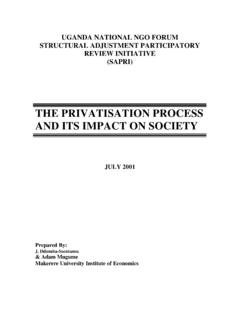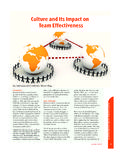Transcription of Weighted Standard Error and its Impact on Significance ...
1 Weighted Standard Error and its Impact on Significance Testing (WinCross vs. Quantum & SPSS). Dr. Albert Madansky Vice President, The Analytical Group, Inc. and Alexander Professor Emeritus of Business Administration Graduate School of Business University of Chicago Researchers who contrast WinCross's treatment of the Standard Error of the Weighted mean with that of Quantum and SPSS have noted some differences. The purpose of this note is to explain the procedure used by WinCross and contrast it with that used by the other two programs. 1. Theory The formula for a Weighted mean is n w x i i xw i 1. n wi 1. i When all the x's are independently drawn from the same population with V(xi)= 2, the variance of the Weighted mean is n 2 wi2. Var ( xw ) n i 1. ( wi ) 2. i 1. Notice that when all the w's =1 ( , when there's no weighting), then this reduces to the usual 2n 2. V ( xw ) 2 V (x ). n n Notice that V( xw ) is of the form 2. V ( xw ) . b where b, the effective base (so called by Quantum), is given by n ( wi ) 2.
2 B i 1. n w i 1. 2. i -1- , effective base = (sum of weight factors) squared / sum of the squared weight factors. Since the critical ingredient in the above computation is V(xi)= 2, the variance of the (unweighted) x's, one way of estimating 2 is by the usual estimate based on the unweighted data, namely n (x x ) i 2. s2 i 1. n 1. This is an unbiased estimate of 2, and therefore s2/b is an unbiased estimate of the variance of the Weighted mean. It is s2 given above that is used in WinCross, in conjunction with the effective sample size b, as the basis for the Standard errors used in Significance testing involving the Weighted mean. 2. SPSS approach SPSS uses a Weighted variance as its estimate of 2. This Weighted variance is given by n w (x x i i w )2. sw2 i 1. n w 1. i 1. i n n wi xi2 ( wi ) xw i 1. n i 1. w 1. i 1. i SPSS also uses nw, the sum of the weights, (and not the effective base) as the sample size in calculating the variance of the Weighted mean. This estimate is not an unbiased estimate of the variance of the Weighted mean.
3 SPSS's justification for using this estimate is that the wi should be considered as the counts of the number of repeats of xi that the weighting system says should be in the data. One then treats each of the repeats of xi as an additional observation, and calculates mean, variance, and sample size by using the Standard formulas across all the repeats. (The fact that the weights are not integers is immaterial, as the formulas work equally well with fractional repeats. ). -2- 3. Example The two computations can be contrasted by considering the following data: weight x 5. 5. 4. 4. 3. 4. 3. 2. 2. 1. Here = , w= , s2= , and sw2= Let nw be the sum of the weights, in this case SPSS exhibits this as its sample size, rounded to the nearest integer, so that it outputs a 10 as the sample size, by rounding down from The true sample size is n=10, and the effective base is b= SPSS estimates the variance of the mean by sw2/nw = ; WinCross estimates the variance of the mean by s2/b= WinCross uses s2/b and SPSS uses sw2/nw in its hypothesis testing.
4 When comparing a Weighted sample mean with some null hypothesis mean value, the denominator of the z-statistic is the square root of their selected estimate of the Standard Error of the Weighted mean. When comparing two independent Weighted means, the denominator of the z-statistic is the root mean square of the two Standard errors , , 2 2. s1 s 2. +. b1 b 2. for WinCross and 2 2. s w1 s w2. +. n w1 n w2. for SPSS. We do not recommend hypothesis testing using the raw means, for it is the Weighted means that are the unbiased estimates of the population means. Thus, since the Weighted means are in the numerators of the test statistic, it is the Standard errors of the Weighted means that should be used in the denominators of the test statistic. The only issue is what is the best estimator of the Standard Error of the Weighted mean. WinCross (and Quantum) use s2/b, and SPSS uses sw2/nw . -3.





